Corporate Governance Framework
Basic Approach
ENEOS Holdings has established the ENEOS Group Philosophy as the foundation for the Group’s business activities, and works to realize the Philosophy through the establishment and appropriate execution of corporate governance to achieve sustainable growth and enhance the corporate value of the ENEOS Group over the medium to long term.
Corporate governance of the ENEOS Group is structured and executed as follows.
Basic Policy on Corporate Governance
To achieve sustainable growth and increase the corporate value of the Group over the medium to long term, the Company established the Basic Policy on Corporate Governance of ENEOS Group with the objective of establishing and operating a corporate governance framework for the conduct of transparent, fair, timely, and decisive decision-making in the Group’s management.
The policy describes systematically and comprehensively the Group’s basic approach to corporate governance as well as its establishment and operation, taking into consideration the Corporate Governance Code established by the Tokyo Stock Exchange.
The policy, published on the Company’s website, is our commitment to all stakeholders, including shareholders of ENEOS Holdings, Group customers, business partners, employees, and local communities.
- Basic Policy on Corporate Governance of ENEOS Group
- (Exhibit 1) ENEOS Group Code of Conduct
- (Exhibit 2) Medium-Term Management Plan
- (Exhibit 3) Basic Policy on Internal Control System
- (Exhibit 4) Standards for Consideration of Independence of Independent Directors
- (Exhibit 5) Disclosure Policy
- (Exhibit 6) Shareholder Return Policy and Capital Policy
- Corporate Governance Report (Available in Japanese only) (updated November 25,2025)
Basic Matters on the Establishment and Operation of Corporate Governance
- 1.Business management as the holding company
- The Company takes charge of formulating the ENEOS Group Philosophy, ENEOS Group Code of Conduct, basic management policies such as medium- to long-term management plans and budgets (hereinafter referred to as “Basic Management Policies”), allocating management resources and overseeing the management of each subsidiary from the perspective of optimizing the value of ENEOS Group as a whole.
- 2.Management structure of the Company and the Principal Operating Companies
- In order to strongly advance portfolio management under the Company’s strong leadership, ENEOS Group has established a structure, under which the Company serves as a holding company and five operating Companies which promote each principal business are placed thereunder.
The Principal Operating Companies: ENEOS Corporation, ENEOS Xplora Inc., ENEOS Materials Corporation, ENEOS Power Corporation, and ENEOS Renewable Energy Corporation shall respectively establish business execution structure where their autonomy, agility, and independence are further enhanced depending on their business characteristics under the Basic Management Policies specified by the Company.
- 3.Organization
- The Company is a company with audit and supervisory committee.
- 4.Board of Directors
- The Board of Directors of the Company consists of more than one inside directors and outside directors, which is chaired by an outside director. With such composition, the Board of Directors of the Company shall manage the Company in accordance with the following policies.
- (1)Focus on deliberation and decision of the Basic Management Policies and oversight of the execution of operations.
- (2)As an effort to improve agility of the execution of operations, delegate part of decision-making on the execution of material operations to the CEO of the Company through a director.
- (3)With respect to the material matters such as appraisal of return on investment, risks, progress of execution of material operations of the Company and the Principal Operating Companies, the Board of Directors shall receive reports from persons such as the CEO of the Company and the President of each Principal Operating Company, verify its consistency with the Basic Management Policies and oversee such matters.
- 5.Audit and Supervisory Committee
-
- (1)The Audit and Supervisory Committee shall carry out audits with a high degree of effectiveness and objectivity conduct audits with a Chairman of an outside director in an organized and systematic fashion through appropriate collaboration between the full-time audit and supervisory committee members, who are given the strong power to gather information, and the audit and supervisory committee members who are outside directors, who have a high degree of independence, in addition to a wealth of knowledge and experience.
- (2)The Audit and Supervisory Committee shall oversee the execution of operations through each audit and supervisory committee member exercising the voting right that he or she has as a director at the Board of Directors meetings as well as exercising the right to state his or her opinion on personnel affairs and compensation of directors who are not audit and supervisory committee members.
- 6.Outside directors
- To take advantage of a wealth of knowledge and experience of outside directors and to ensure transparency and objectivity in decision-making, the Company shall take the following measures:
- (1)in determining the Basic Management Policies at the Board of Directors of the Company, request outside directors to be involved, from the stage of consideration and to fully discuss it from multiple points of view; and in decision-making on and overseeing execution of material operations, fully verify its consistency with the Basic Management Policies, taking opinions of outside directors into account; and
- (2)in determining personnel affairs and remuneration of directors at the Board of Directors of the Company, ensure transparency of the decision-making process by consulting with the Nomination Advisory Committee and the Compensation Advisory Committee, a majority of whose members are outside directors, and which are chaired by an outside director.
- 7.Executive officers, Group Chief Officers, and the Executive Council
-
- (1)The Company shall appoint executive officers who execute operations agilely pursuant to a decision of the Board of Directors.
- (2)In order to enhance group governance, the Company shall appoint Group Chief Officers as the roles by which strengthening collaboration among the Principal Operating Companies, optimizing resource allocation, etc.
- (3)For the CEO to execute operations, the Company shall establish the Executive Council as a consultative body for matters to be decided by the CEO, which shall consist of the CEO, the Executive Vice Presidents, the Senior Vice Presidents who have been appointed by the CEO, and the President of each Principal Operating Company, and have the Executive Council make decisions through careful deliberations.
- (4)A full-time audit and supervisory committee members shall attend the Executive Council, grasp a process of important decision-making, and the status of execution of operations, and share such process and status with other audit and supervisory committee members.
- 8.Corporate governance framework of Principal Operating Companies
-
- (1)Each Principal Operating Company is a company with audit and supervisory committee or company with board of corporate auditors (as defined in the Companies Act of Japan). Each Principal Operating Company has a Board of Directors to enable directors to oversee each other’s performance of duties. Each Principal Operating Company shall fully analyze the risk of the business and verify the conformity of the execution of operations performance to the Basic Management Policies. The Company shall dispatch, if necessary, its full-time audit and supervisory committee member to the Principal Operating Companies as a part-time director who is an audit and supervisory committee member or a part-time corporate auditor, and cause such director or corporate auditor to audit the execution of the duties by the directors of the Principal Operating Company.
- (2)Any decision-making regarding the matters related to the execution of operations of a Principal Operating Company (including matters on the execution of material operations of a subsidiary of such Principal Operating Company) shall be made by such Principal Operating Company.
- (3)Each Principal Operating Company shall report to the Company the status and other matters established by the Company regarding the execution of material operations.
- (4)In order to appropriately monitor the Board of Directors of the Principal Operating Companies or audit the execution of the duties by the directors of the Principal Operating Companies, the Company shall dispatch, if necessary, its Executive Vice Presidents or Senior Vice Presidents to the Principal Operating Companies as part-time directors who are not audit and supervisory committee members or part-time directors, or part-time director who are audit and supervisory committee members or part-time corporate auditors of the Principal Operating Companies.
Structure
Corporate Governance Framework
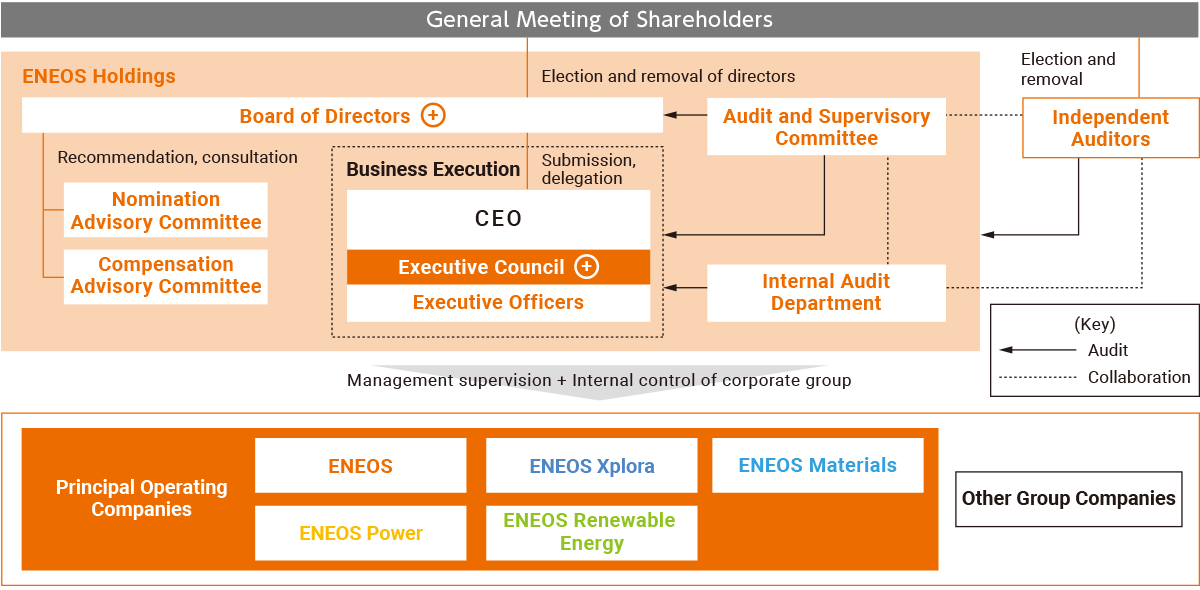
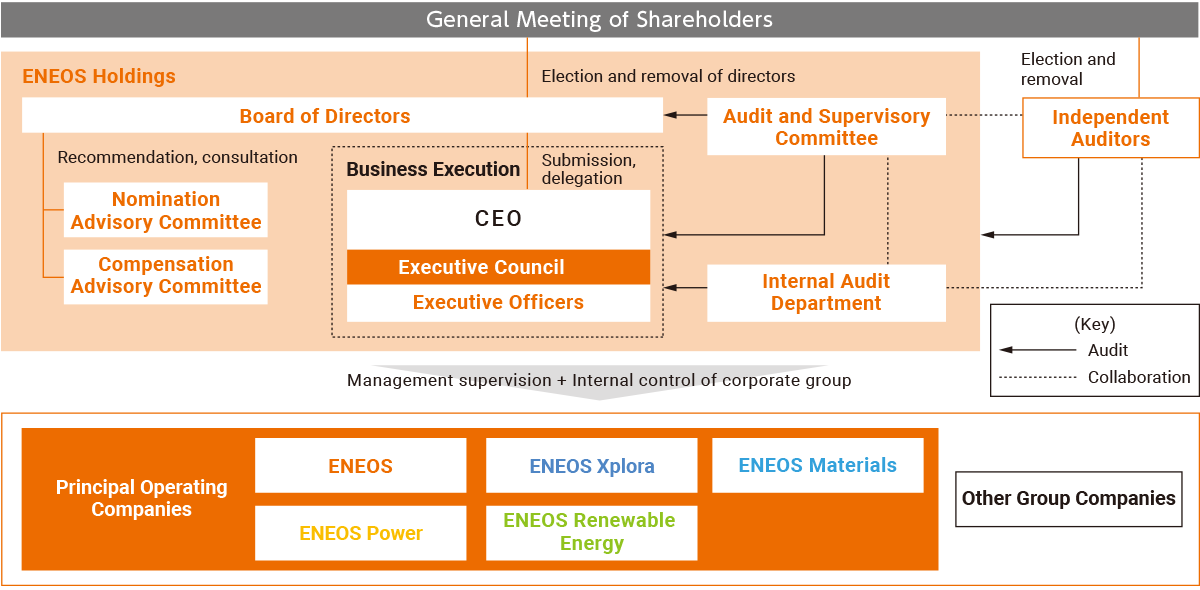
Board of Directors
The Board of Directors makes decisions on matters stipulated by laws, regulations, or the Articles of Incorporation; the medium-term management plan; important matters regarding business execution for the Company and Principal Operating Companies; etc.
Executive Council
The Executive Council has been formed to discuss matters related to operational execution that require the approval of the CEO. This council is composed of the CEO, the Executive Vice Presidents, the Senior Vice Presidents who have been appointed by the CEO, and the CEO/President of each Principal Operating Company.
Thus, at the Executive Council, through careful deliberation by executive members of the Company and the Principal Operating Companies, appropriate and efficient decisions by the CEO are secured.
Corporate Governance Framework at a Glance (As of June 26, 2024)
| Item | Details |
|---|---|
| Organization format | Company with an audit and supervisory committee |
| Number of directors who are not Audit and Supervisory Committee members* | 6 (2 inside, 4 outside) |
| Number of directors who are Audit and Supervisory Committee members* | 4 (1 inside, 3 outside) |
| Total number of directors | 10 (3 inside, 7 outside; 4 female directors) |
| Percentage of outside (independent) directors | 70% |
| Percentage of female directors | 40% |
| Chairman of the Board of Directors | Outside director |
| Term of directors who are not Audit and Supervisory Committee members | 1 year |
| Term of directors who are Audit and Supervisory Committee members | 2 years |
| Adoption of executive officer system | Yes |
| Decision-making body for the appointment and dismissal of directors | General Meeting of Shareholders |
| Decision-making body for the upper limit of director remuneration | General Meeting of Shareholders |
| Institution assisting the CEO's decision-making | Executive Council |
| Voluntary advisory committees for the Board of Directors | Nomination Advisory Committee and Compensation Advisory Committee (1 inside director, 4 outside directors; chairman: outside director) |
| Term of Independent Auditors | 1 year |
- * At the most recent General Meeting of Shareholders (14th Ordinary General Meeting of Shareholders), two directors who are Audit and Supervisory Committee members received 10% or more opposing votes; however, the Company considers there is no issue regarding two directors’ independence and they are expected to provide the Company with guidance and advice on its management, and the Company disclosed such opinion.
Overview of the Nomination Advisory Committee and Compensation Advisory Committee and Fiscal 2023 Results
| Nomination Advisory Committee | Compensation Advisory Committee | |
|---|---|---|
| Overview | To ensure the transparency of the process for determining the director candidates of the Company, the Nomination Advisory Committee, the majority of whose members are independent outside directors, has been established to provide advice to the Board of Directors about personnel matters involving the Company’s directors (including appointment and dismissal). The Nomination Advisory Committee is composed of five directors, four of whom are outside directors1,2, and one of the outside directors on the committee acts as chairman. The Company’s Board of Directors receives advice from the Nomination Advisory Committee regarding succession planning for the Company’s chairman of the Board and CEO and for the CEOs/presidents of the principal operating companies. | To ensure the transparency and objectivity of the process for determining the remuneration and other benefits for directors and executive officers, the Compensation Advisory Committee, the majority of whose members are independent outside directors, has been established to provide advice to the Board of Directors. The Compensation Advisory Committee is composed of five directors, four of whom are outside directors1,2, and one of the outside directors on the committee acts as chairman. The Board of Directors requests the Compensation Advisory Committee to advise on policies for determining remuneration and other benefits for directors and executive officers, as well as the executive remuneration plan and remuneration amount. |
| Chairman | Outside director (Kudo Yasumi)3 | Outside director (Kudo Yasumi)3 |
| Purpose | Ensure the transparency of the process for determining director candidates | Ensure the transparency and objectivity of the process for determining the remuneration and other benefits for directors and executive officers |
| Results for fiscal 2023 | The committee met seven times and deliberated on matters including the officer structure from fiscal 2024 onward, the process for appointing directors, and the succession plan. | The committee met six times and deliberated on matters including performance-linked remuneration indicators during the period of the third Medium-Term Management Plan and the executive remuneration system after the revision of the Group management structure. |
- 1Composition of the Nomination Advisory Committee and the Compensation Advisory Committee as of June 26, 2024
- 2To ensure constructive discussion between outside directors, who supervise management from an independent and objective perspective, and inside directors, who have the greatest familiarity with the status of management, etc. in the Group, the Nomination Advisory Committee and the Compensation Advisory Committee are each comprised of outside directors who are not Audit and Supervisory Committee members and the CEO.
- 3For director profiles, see Executives.
Strengthening Corporate Governance
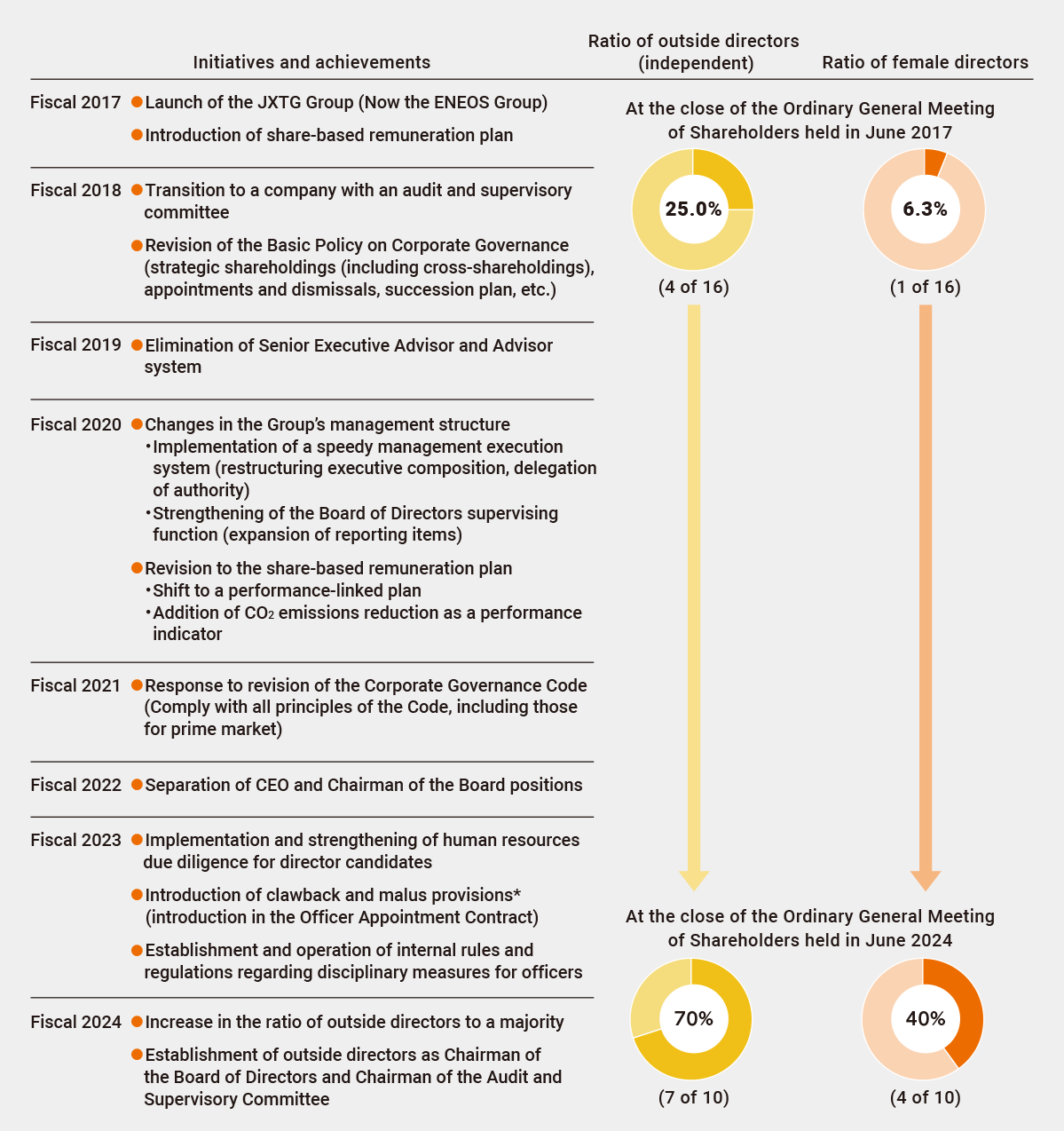
- * Clawback provision: A clause requiring the return of all or part of officer remuneration after payment in the event of a material compliance violation.
Malus provision: A clause preventing the vesting of all or part of officer remuneration before payment in the event of a material compliance violation.
Material Issues, Plans and Results
Fiscal 2023 Targets, Results and Progress
Evaluation:Achieved/Steady progressNot achieved
| Material ESG Issue | Initiative | Target (KPI) | Results/Progress | |
|---|---|---|---|---|
| Appropriate structuring and operation of corporate governance | Evaluation of the effectiveness of the Board of Directors |
|
|
|
Major Initiatives
Evaluation of the Effectiveness of the Board of Directors
Since fiscal 2016, the Company’s Board of Directors has conducted annual evaluations of its effectiveness, which serve as a basis for improvement.
In November 2023, the Board of Directors surveyed all directors, including outside directors, to evaluate the Board’s effectiveness in fiscal 2023. In addition, in fiscal 2022 we engaged a third-party organization to update the survey questions to ensure the objectivity and transparency of the evaluations. The same survey questions were used in fiscal 2023 to identify any ongoing issues and the status of improvements. The results of the evaluation and analysis were reported at the Board of Directors meeting on March 27, 2024.
Evaluation Items
- 1.Composition and operation of the Board of Directors
- 2.Role of the Board of Directors
- Presentation of major directions, such as corporate strategies
- Establishment of a supportive environment for appropriate risk-taking by management
- Highly effective supervision from an independent standpoint
- 3.Dialogue with shareholders
All of the survey questions received mostly positive responses, and the average scores for all items and for individual major items improved for both inside and outside officers compared to fiscal 2022, indicating that the Board of Directors generally continues to be effective.
The results also indicated areas with relatively low evaluations and areas where further improvement is needed. We are accordingly working toward implementation of the following.
- 1.Enhancing the provision of information to outside directors by sharing the content of Executive Council discussions and through worksite and business site inspections tours, and other activities
- 2.Broadening discussions on the Group’s overall management strategies and capital policies under the new Group management structure, and further strengthening the leadership role of the chairman of the Board of Directors to stimulate more active discussion from the optimal perspective for the entire Group
- 3.Further improving the monitoring function of the Board of Directors by providing outside directors with information on risks and investments from a wide range of perspectives
- 4.Continue improving the transparency of governance (ratio of outside directors on the Board of Directors over 50%, outside director serving as chairman of the Board of Directors) and restructuring the succession plan for the enhancement of the ENEOS Group
The following initiatives were implemented to “further strengthen the oversight function” and “raise the quality of discussions and explanations by the Board of Directors,” which were identified as issues to address in the fiscal 2022 Board of Directors effectiveness evaluation.
- 1.Introduced human resources due diligence and rules and regulations regarding disciplinary measures for directors and director candidates, and ensured objectivity and transparency in the officer appointment and dismissal process.
Additionally, in light of the misconduct of the former president in December 2023, we have revised the director selection process, and we are working to enhance the normative awareness of officers and strengthen the behavioral management and monitoring of directors. - 2.To stimulate discussions among the Board of Directors, in principle, outside directors and executives meet before and after Board of Directors meetings to exchange opinions on specific business policies and other matters.
- 3.Discussed the Group’s overall management strategy from fiscal 2024 onward under the new Group management structure.
In addition, the Company’s Audit and Supervisory Committee conducted an evaluation of the effectiveness of the Company’s audit activities in fiscal 2023. Issues are communicated among the Audit and Supervisory Committee members and will be reflected in the audit plan for fiscal 2024, as we seek to construct an effective auditing system.
Process for Evaluation of Effectiveness
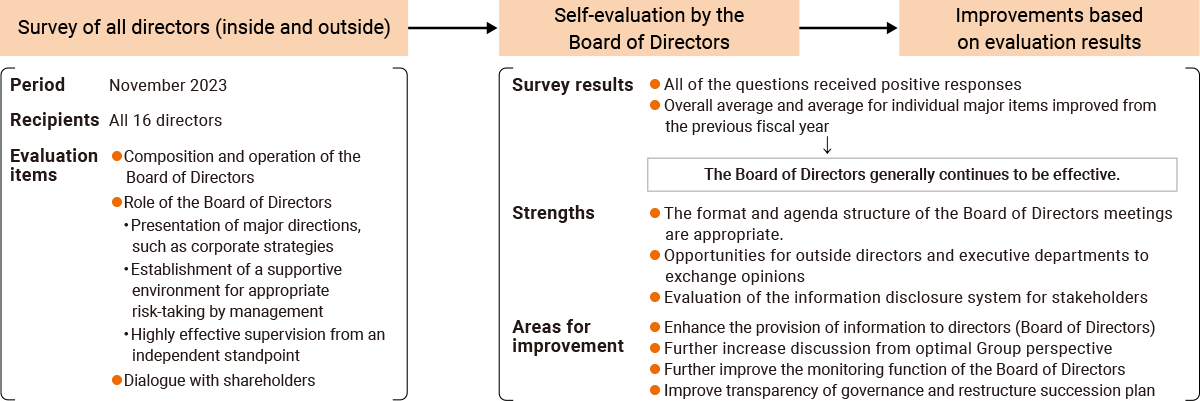
Policy for Appointing Director Candidates
The Board of Directors is composed of an appropriate number of members to enable free and constructive discussion and exchange of opinions, with members appointed in consideration of Board diversity and the knowledge, experience, and abilities of each member. The Company appoints independent outside directors* to a majority of director positions. As of June 26, 2024, the percentage of outside independent officers was 70%.
To ensure objectivity and fairness in the selection of director candidates, excluding outside director candidates, a third-party entity evaluates the candidates from various perspectives and appropriate considerations (human resources due diligence and director candidate interviews). Prior to appointment, the Nomination Advisory Committee deliberates the evaluation results and reports to the Board of Directors.
As for directors who are not Audit and Supervisory Committee members, the Company appoints persons with high standards of business ethics, superior strategic thinking and judgment capabilities, and flexible attitudes toward change, as well as the ability to supervise decision-making and management from the viewpoint of what is best for the Group as a whole. Two or more of the directors are independent outside directors.
As for directors who are Audit and Supervisory Committee members, the Company appoints persons with high standards of business ethics, a certain level of specialist knowledge in legal affairs, finance and accounting, etc., as well as the ability to appropriately audit the execution of duties by directors and the ability to appropriately supervise the execution of business. The majority of these directors are independent outside directors.
- *Outside directors who have satisfied the Company’s “Standards for Consideration of Independence of Independent Officers”
Support System for Outside Directors
Each of the four outside directors who are not Audit and Supervisory Committee members and the three outside directors who are Audit and Supervisory Committee members meet the independence standards based on the rules of the Tokyo and Nagoya stock exchanges, on which the Company is listed. The Company sends materials regarding the agenda of meetings of the Board of Directors to the outside directors, in principle, at least three days prior to meetings, and also provides explanations to the outside directors about important agenda items before the meetings. To enhance the auditing function by all Audit and Supervisory Committee members, including outside directors, the Company has established the Office of the Audit and Supervisory Committee, which is clearly independent from the chain of command for divisions responsible for business execution (including personnel evaluations). Full-time staff members have been assigned to the office to assist with the duties of the Audit and Supervisory Committee members. In addition, an organization with full-time staff members has also been established within the Legal and Corporate Affairs Department to assist outside directors who are not Audit and Supervisory Committee members with business execution.
Training for Directors and Corporate Auditors of Principal Operating Companies
The directors of the Company and principal operating companies and the corporate auditors of principal operating companies have the duty of working toward the realization of the Group Philosophy, the sustainable growth of the Group, and the achievement of increased corporate value over the medium to long term. To that end, to enhance necessary knowledge and skills, the Company and its principal operating companies provide opportunities for directors and corporate auditors to receive training related to the Companies Act, internal control systems, accounting and taxes, business strategies, and organizations. In addition, the Company pays expenses related to self-study initiatives. When outside directors are appointed, the Company provides explanations of basic matters regarding the Group’s businesses and, after their appointment, offers business presentations and worksite inspection tours to deepen their understanding.
Results for Fiscal 2023 and Forecast for Fiscal 2024
| Topic | Intended for | Fiscal year | Content of training |
|---|---|---|---|
| Respect for human rights, compliance | Inside directors | 2023 2024 |
Group Philosophy and Code of Conduct, prevention of human rights violations and harassment, etc. |
| Corporate governance | Newly appointed | 2023 2024 |
ENEOS Group corporate governance |
| Internal control | Newly appointed | 2023 2024 |
ENEOS Group internal control systems |
| Finance and investor relations | Newly appointed | 2023 2024 |
Current status and issues regarding ENEOS Holdings’ financial affairs, opinions of institutional investors, etc. |
| ENEOS Holdings and principal operating companies | Newly appointed directors (outside directors) |
2023 2024 |
Basic knowledge about ENEOS Holdings and its principal operating companies |
| Worksite inspection tours | Outside directors | 2023 |
(ENEOS) Kashima Refinery, (ENEOS Xplora) Nakajo Field Office, (ENEOS Materials) Kashima Plant |
| 2024 (Planned) | (ENEOS) Central Technical Research Laboratory, etc., (ENEOS Power) Goi Thermal Power Plant |
Determination of Director Remuneration
Directors Who Are Not Audit and Supervisory Committee Members (Excluding Outside Directors)
The policy on remuneration for individual directors who are not Audit and Supervisory Committee members (excluding outside directors) is determined as follows.
- 1.Remuneration consists of the monthly remuneration, bonus, and share-based remuneration.
- 2.Remuneration is determined by whether the person belongs to the Company or a principal operating company, whether the person is full-time or part-time, whether the person is a director or executive officer, etc.
- 3.Bonuses are linked to performance within a fiscal year, and are paid after the given fiscal year.
- 4.Share-based remuneration is linked to the achievement of the Medium-Term Management Plan, etc., and is paid after a certain duration from the end of the fiscal year in which the duties have been executed and after the given medium-term management plan has been completed.
- 5. The consolidated business results, remuneration levels of executives in other companies, composition ratio, etc. are taken into consideration when determining the remuneration level, composition ratio, performance indicators, etc.
Remuneration for directors who are not Audit and Supervisory Committee members (excluding outside directors) is designed to be around 40% of the total for monthly remuneration, around 30% of the total for bonuses, and around 30% of the total for share-based remuneration when the performance targets, etc. are achieved. In addition, the Company may request that remuneration and other compensation be returned and/or forfeited in accordance with the provisions of the Officer Appointment Contract and rules and regulations regarding disciplinary measures for officers. The maximum amount of the remuneration and compensation subject to return and/or forfeit is the total amount for four fiscal years.
Outside Directors Who Are Not Audit and Supervisory Committee Members
The policy on remuneration for individual outside directors who are not Audit and Supervisory Committee members is to provide a monthly remuneration only in consideration of their roles of providing guidance and advice to Company management and supervising management from an independent and objective perspective.
The policy on remuneration for individual directors who are not Audit and Supervisory Committee members of the Company is determined by resolution of the Board of Directors after deliberation and recommendation by the Compensation Advisory Committee, which consists of a majority of outside directors and is chaired by an outside director. The Board of Directors allows the Audit and Supervisory Committee to select one member to attend meetings of the Compensation Advisory Committee so that the Audit and Supervisory Committee may adequately exercise the right to state opinions related to the remuneration of directors who are not Audit and Supervisory Committee members at General Meetings of Shareholders.
Directors Who Are Audit and Supervisory Committee Members (Including Outside Directors)
Remuneration for directors who are Audit and Supervisory Committee members consists of a monthly remuneration only in consideration of the independence of their roles based on discussions among directors who are Audit and Supervisory Committee members. The parameters of the remuneration are shown in the following table.
Upper Limit of Remunerations for Directors
| Category | Type | Upper limit of remuneration | Resolution of the General Meeting of Shareholders (GMS) | Number of receivers (Persons) |
|---|---|---|---|---|
| Directors who are not Audit and Supervisory Committee members | Monthly remuneration and bonuses |
No more than 1,100 million yen per one (1) fiscal year (of which no more than 200 million yen is allocated to outside directors who are not Audit and Supervisory Committee members) | The 8th ordinary GMS (June 27, 2018) |
13 |
| Share-based remuneration | In every three (3) fiscal years,
|
The 10th ordinary GMS (June 25, 2020) |
6 | |
| Directors who are Audit and Supervisory Committee members | Monthly remuneration | No more than 200 million yen per one (1) fiscal year | The 8th ordinary GMS (June 27, 2018) |
5 |
- Note:
- Those eligible for share remuneration include executive officers but do not include outside directors and overseas residents.
Remunerations for Directors (Fiscal 2023)
| Category | Total amount (Million yen) |
Details of remuneration (Million yen) |
Number of receivers (Persons) | Details of remuneration (Million yen) |
Number of receivers (Persons) | Details of remuneration (Million yen) |
Number of receivers (Persons) |
|---|---|---|---|---|---|---|---|
| Monthly remuneration | Bonuses | Share-based remuneration | |||||
| Directors who are not Audit and Supervisory Committee members (Outside directors) |
688 (54) |
396 (54) |
12 (4) |
187 (-) |
4 (-) |
106 (-) |
5 (-) |
| Directors who are Audit and Supervisory Committee members (Outside directors) |
119 (50) |
119 (50) |
7 (4) |
- (-) |
- (-) |
- (-) |
- (-) |
| Total (Outside directors) |
807 (104) |
515 (104) |
19 (8) |
187 (-) |
4 (-) |
106 (-) |
5 (-) |
- Notes:
- 1.The information in the table includes the amount of remunerations for one (1) outside director who was not an Audit and Supervisory Committee member, two (2) directors who were Audit and Supervisory Committee members (including one [1] outside director who was an Audit and Supervisory Committee member) who retired upon the conclusion of the 13th Ordinary General Meeting of Shareholders held on June 28, 2023, and two (2) directors who were not Audit and Supervisory Committee members who retired on December 19, 2023.
- 2.Includes the amount of bonuses received for fiscal 2023 after the conclusion of the 14th Ordinary General Meeting of Shareholders.
- 3.Monthly remuneration, bonus, and share-based remuneration subject to confiscations, reductions, or voluntary returns, announced on June 9, 2023, and December 19, 2023, are not included in the above table. However, because monthly remuneration had already been paid for October through December 2023 (total of 18 million yen) to one Director who was not an Audit and Supervisory Committee member and who retired on December 19, 2023, the amount is included in the above table, but the Company has received a full refund of the amount.
- 4.Bonuses and share-based remuneration are applicable to performance-linked remunerations. In addition, share-based remuneration is applicable to non-monetary remunerations.
- 5.The share-based remuneration amounts indicated in the table are the average price per share of the Company purchased through the trust that the Company established multiplied by the number of standard points awarded to the Director in the fiscal year and the performance-linked coefficient. Whereas the performance-linked coefficient used to calculate share-based remuneration for April 2023 to June 2023 is 68%, the performance-linked coefficient used to calculate share-based remuneration for July 2023 to March 2024 is temporarily assumed to be 100% because it will be determined after the end of fiscal 2025.
Matters Concerning Bonuses
Bonuses are linked to performance within a single fiscal year and can fluctuate between 0% and 200% (target: 100%) depending on the level of achievement of the performance targets. Bonuses are determined by multiplying the monthly remuneration by the base number of months (8 months) and the percentage of target achieved.
The indicators that affect shareholder returns and the indicators that reflect actual performance should be used when calculating the percentage of target achieved. Therefore, “profit attributable to owners of parent” and “profit attributable to owners of parent after adjustment” of the Company’s consolidated results, and “operating profit” and “operating profit after adjustment” of the Energy business results are used as performance indicators with a weight of 25% each.
The fiscal 2023 performance target for the bonus calculation process was set based on the fiscal 2023 results forecast (disclosed in May 2023), and the resulting percentage of target achieved was 152%. The results of each performance indicator to calculate the percentage of target achieved are as follows.
Results for Each Performance Indicator for Bonuses
| Performance indicators | Weight | Results in FY2023 |
|---|---|---|
| Profit attributable to owners of parent | 25% | 288,100 million yen |
| Profit attributable to owners of parent after adjustment | 25% | 279,300 million yen |
| Operating profit of the Energy business | 25% | 253,000 million yen |
| Operating profit of the Energy business after adjustment | 25% | 215,600 million yen |
- Note:
- “Profit attributable to owners of parent after adjustment” and “operating profit of the Energy business after adjustment” are calculated by adding or subtracting temporary gain/loss, such as gain/loss on valuation of inventory, gain/loss on sale of fixed assets and shares, and loss by disasters, to or from profit attributable to owners of parent and operating profit of the Energy business.
Matters Concerning Share-based Remuneration
Share-based remuneration is linked to performance over three successive fiscal years and can fluctuate between 0% and 200% (target: 100%) depending on the level of achievement of the performance targets. The share delivery points (one share per point) are determined by multiplying the standard points, awarded according to the eligible person’s role, by the performance-linked coefficient. Eligible persons shall receive payment of money and the Company’s shares through the trust established by the Company, according to the share delivery points, after the elapse of three years from the award of standard points for each year.
When calculating the performance-linked coefficient, the Company uses the following performance indicators and evaluation weightings for the following reasons: to further strengthen the link between medium- and long-term management strategies and the remuneration system for eligible persons, to cultivate the eligible persons’ incentive to contribute to the enhancement of corporate value and their awareness of shareholder-oriented management, and to promote initiatives, such as preserving the environment, for building a sustainable society.
Each of the performance targets is set based on the third Medium-Term Management Plan, and the results and percentage of target achieved will be determined after the end of fiscal 2025.
Results for Each Performance Indicator for Share-based Remuneration
| Profit for the year excluding inventory valuation | Free cash flow | Reduction of GHG emissions | Net D/E ratio | ROE | ROIC |
|---|---|---|---|---|---|
| 20% | 20% | 10% | 10% | 20% | 20% |
- Notes:
- 1.Profit for the year excluding inventory valuation, free cash flow, and reduction of GHG emissions reflect the consolidated results and the results of the Energy business, given a weight of 50% each.
- 2.Of the amount of profit for the year excluding inventory valuation, the percentage achieved for results of the Energy business is calculated after excluding incubation projects (projects that are not suitable for evaluation as a business, such as those currently in the demonstration phase) and finance income/expense, etc.
- 3.The percentages achieved for profit for the year excluding inventory valuation, and free cash flow are calculated using the accumulated results from fiscal 2023 to fiscal 2025.
- 4.The percentage achieved for reduction of GHG emissions is calculated using the results of fiscal 2025 (compared with fiscal 2013).
- 5.The percentage achieved for net D/E ratio is calculated using the results as of March 31, 2026.
- 6.The percentages achieved for ROE and ROIC are calculated using the results of fiscal 2025.
- 7.The percentage achieved for ROIC is calculated after excluding incubation projects.
Flowchart of Share Remuneration with Regard to the Period of the Third Medium-Term Management Plan
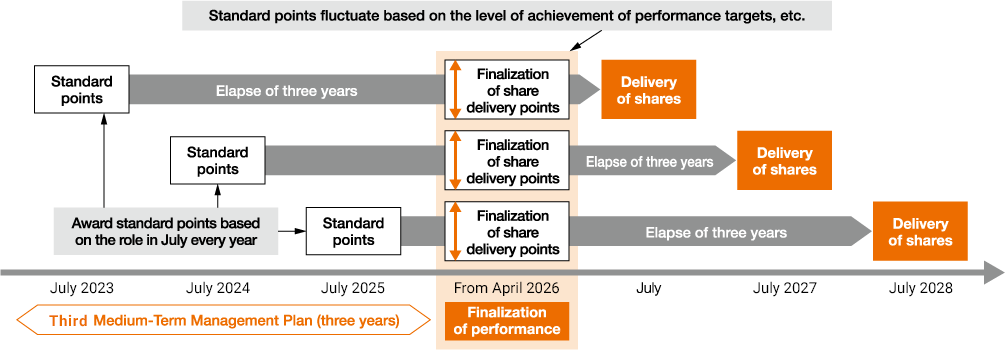
Selection of Independent Auditor
The selection, dismissal, or non-reappointment of the Independent Auditor is resolved every fiscal year in accordance with the policy established by the Audit and Supervisory Committee. Prior to the resolution, the Independent Auditor is evaluated once a year in accordance with the standards established by the Audit and Supervisory Committee.
The Audit and Supervisory Committee has resolved to reappoint the current Independent Auditor as it has been confirmed that there are no issues pertaining to the evaluation items, that the Independent Auditor has sufficient systems and ability to handle the Company’s audit work, and that there are no grounds for dismissal or non-reappointment.
The rotation of executive Representative Partners of the current Independent Auditor has been implemented appropriately, and they have not been involved in the Company’s audit operations for more than seven consecutive fiscal years. The head Representative Partner has not been involved in the Company’s audit operations for more than five consecutive fiscal years.
Governance of Listed Subsidiaries
The Company maintains ENEOS Corporation, ENEOS Xplora Inc., ENEOS Materials Corporation, ENEOS Power Corporation, and ENEOS Renewable Energy Corporation, its principal operating companies, as wholly owned subsidiaries or specially controlled companies, and maintains other Group companies as wholly owned subsidiaries, listed subsidiaries, listed affiliates, or other types of entities based on the need to maintain or expand its businesses. The policy of the Board of Directors is to regularly examine the appropriateness of maintaining a company as a listed subsidiary or listed affiliate from the perspective of improving the Group’s overall corporate value and capital efficiency, to consider the reasonableness of maintaining the listed company status, and to deliberate on the effectiveness of the listed subsidiary’s governance system.
The Company maintains no listed subsidiaries as of March 19, 2025.
Policy on Strategic Shareholdings
Strategic Shareholdings
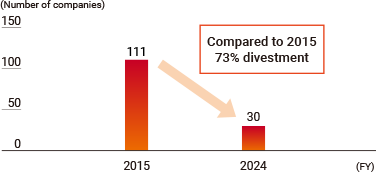
In accordance with the Basic Policy on Corporate Governance of ENEOS Group, in principle, the Company shall not hold shares in listed companies. As an exception, the Company may hold shares in listed companies as strategic shareholdings, as described below.
- 1)Shares in companies which engage in any important businesses of ENEOS Group
- 2)Shares in companies which ENEOS Group judges necessary to maintain or enlarge business of ENEOS Group
The Company has divested 73% of its strategic shareholdings since the above policy was adopted in November 2015. In fiscal 2023, the Company sold shares (valued at 20,573 million yen)* of five companies and did not acquire any new strategic shareholdings.
- * Includes partial divestment of shareholdings
Method of Verifying the Rationality of Possession
With respect to exceptionally holding strategic shareholdings, the Company shall periodically assess whether or not to hold each individual strategic shareholding, specifically examining whether the purpose is appropriate and whether the benefits and risks from each holding cover the company’s cost of capital at the Board meeting of the Company.
Board of Directors Verification of the Appropriateness of Individual Strategic Shareholdings
The Company assessed whether or not to hold each individual strategic shareholding, specifically examining whether the purpose is appropriate and whether the benefits (transactional profits, dividends, benefits difficult to quantify) and risks from each holding cover the company’s cost of capital at the Board meeting of the Company in November 2023.
Risk Management
The ENEOS Group has established the Basic Policy on Internal Control System for the development and implementation of a system for ensuring the appropriateness of our business operations.
Enterprise Risk Management (ERM)
Risk Assessment Matrix
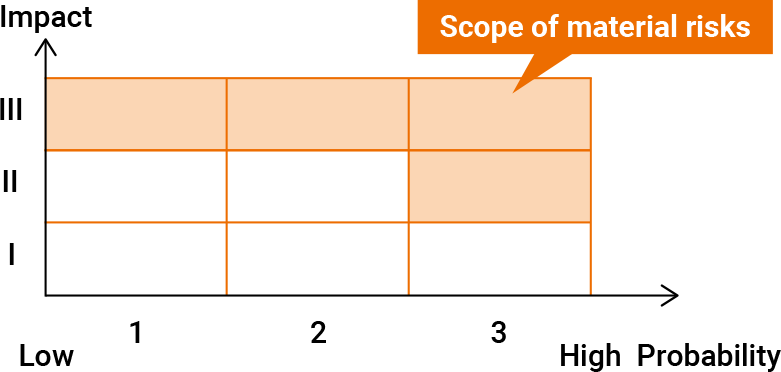
The Company has developed and operates a risk management system to identify and analyze Group management risks and ensure appropriate responses.
Risks (tangible and intangible) are identified, taking into account risks identified up to the previous fiscal year, as well as increased risks and potential new risks arising from changes inside and outside the Company, and are assessed for materiality based on the degree of impact, probability and urgency. Risks that are indicated by assessment results as requiring a response from the Group are designated as “material risks” by resolution of the Executive Council, which is chaired by the CEO of the Company. Relevant departments are assigned for response to material risks, and monitoring is carried out by reporting the status of response to the Executive Council.
Impact
| Impact | Qualitative criteria |
|---|---|
| III | Potential for significant impact on the entire Group, immediate implementation of countermeasures required |
| II | Potential for some degree of impact on the entire Group, consideration of specific countermeasures required |
| I | Potential for minimal impact on the Group as a whole, response can be implemented by individual Group companies |
Probability and Urgency
| Probability (standard) | Urgency (standard) | |
|---|---|---|
| 3 (High) | Has already occurred or is very likely to occur | Response required within 1 year |
| 2 (Medium) | Not very likely to occur, but could occur in the medium term | Consideration of response required for the medium term (up to 3 years) |
| 1 (Low) | Very unlikely to occur in the short or medium term | Consideration of response required for the long term (over 3 years) |
Risk Management System at Principal Operating Companies
The Group’s principal operating companies maintain and operate their own risk management systems, which are tailored to their specific business content and characteristics. The departments in charge of risk management at the Company and the principal operating companies cooperate and share risk information with each other. If a company identifies, through its risk management process, a risk that could significantly impact the management of the Group, ENEOS Holdings and the company work together to respond to the risk.
Internal Control
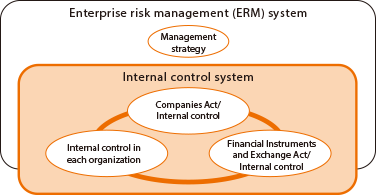
The Internal Control Department has developed and operates the internal control system for the ENEOS Group. The system links the internal controls stipulated in the Companies Act and the Financial Instruments and Exchange Act, and the internal controls of each Group organization.
As part of this system, the Group has formulated internal controls based on the COSO Framework* for independent management by each organization. Introduction of the internal controls has been completed for the Company and Group companies.
From fiscal 2024, with the increase in the number of principal operating companies to six, we will utilize information technology to improve the efficiency of the internal control system as part of our efforts to improve the effectiveness of the internal control and risk management systems.
- *Committee of Sponsoring Organizations of the Treadway Commission (COSO) is an internal control framework released by the commission and adopted by countries around the world.
Comprehensive Internal Control Structure
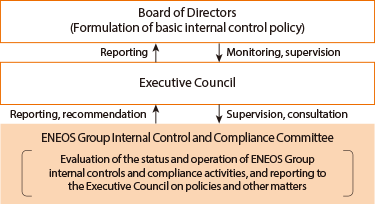
- * Image represents the structure through fiscal 2023.
The Company has established the ENEOS Group Internal Control and Compliance Committee, chaired by the officer responsible for the Internal Control Department and the Legal & Corporate Affairs Department. The committee works to continuously improve the internal control system for the Group. Until fiscal 2023, the committee confirmed and evaluated the status and operation of the internal control system once a year and reported its findings to the Executive Council. In fiscal 2024, with the increase in the number of principal operating companies to six, we will review the system to improve monitoring effectiveness.
Every April, the committee reports to the Board of Directors on the status and operation of the internal control system and on specific points of policies for initiatives for the fiscal year. The Board of Directors appropriately monitors and supervises the internal control system for the Group and fulfills its duty of accountability by providing an overview of the operation status in the Business Report section of the Report document accompanying the Convocation Notice of the General Meeting of Shareholders.
Risk Assessment of Business Activities
The Group has internal rules and regulations for addressing the risks in its business activities. For the screening of new investments, in addition to country risks and foreign exchange rate risks, we analyze and evaluate ESG-related risks, including environmental risks such as those related to the scope of response to biodiversity and environmental regulations; risks in the procurement of raw materials, including water; and human resources risks, including those related to human rights and occupational health and safety, and we take appropriate actions when necessary.
In addition, when reviewing proposed major investments, we perform screenings based on the stage-gate system. The process from initial examination to execution of an investment project is divided into multiple stages of examination, and deliberations are conducted at each stage. During the deliberations, we clarify various risks, including ESG-related risks, using sensitivity analysis, case analysis, along with cold-eye review by a third party and other means, and work to minimize these risks. For important investments, follow-up is carried out after a certain period of time to clarify impacts on the initial outlook caused by environmental changes or other factors and to determine whether to continue with the project.
Crisis Management
In the event of a crisis situation that could significantly affect the management of the Group, the Company responds quickly and appropriately in accordance with the ENEOS Group Rules for Responding to Crises and Emergencies and has systems in place to minimize any damage that may occur.
The Group’s basic stance on crisis situations is to place the highest priority on protecting human life, issue information promptly and implement centralized information management, quickly determine, execute, and follow up the most effective response measures, implement transparent and smooth communications, and prevent recurrence.
With the Crisis Management Department as the standing organizational unit, in the event of a crisis situation, we maintain a system enabling immediate reporting on conditions and the status of response measures from the site of an incident. Depending on the magnitude of the crisis, we may set up a response headquarters, led by the president, and organize response teams at the head office and at the site of the incident to ensure agile and effective response.
Infectious Disease Prevention Measures
The Group’s basic policy is to (1) place the highest priority on respect for human life and make every effort to protect against and prevent the spread of infectious diseases to the Group’s officers, employees and their families, and (2) engage all Group companies in maintaining a continuous supply of our products, which support the functioning of society. In the event that management is significantly affected by an infectious disease epidemic, a system is in place to set up a response headquarters, led by the president, to ensure the prompt determination and execution of countermeasures.
ENEOS has business continuity plans at its head office, branch offices, refineries, and other sites to ensure that we can fulfill our responsibility of providing a stable supply of petroleum products, even during an epidemic. To protect employees from infection and prevent the spread of disease, we systematically stockpile surgical masks, goggles, alcohol-based disinfectants, and other items at our business sites in Japan and overseas. We also maintain a system and an IT environment that enable employees to work from home.
Information Security
Company information is an important asset of the Group, and we work to prevent the improper use, disclosure, or leakage of this information in accordance with the ENEOS Group Basic Rules for Information Security. The Group also strives to maintain information accuracy and reliability and to prevent falsification or mishandling while ensuring that information is available to authorized users when needed.
In addition, the Company and ENEOS have developed personal information protection procedures and established rules to ensure compliance with the Personal Information Protection Act and the appropriate handling of personal information to protect people’s rights.
Following the leak of personal customer information at ENEOS in fiscal 2021, we carried out a Group-wide inspection of legal compliance focused primarily on the protection of personal information and conducted e-learning training for all employees of the Company and ENEOS in fiscal 2022 and again in fiscal 2023.
At the Company and ENEOS, when a leak of personal information is detected, it is immediately shared among the relevant departments and reported to the Personal Information Protection Commission as necessary. In such cases, we conduct prompt root cause analysis and response to prevent the spread of damage. We are also working to prevent recurrence through efforts such as providing training on personal information protection laws to all employees. We will continue working to strengthen our personal information management systems to ensure appropriate management.
Cybersecurity Measures
In order to protect its important information and systems from cyberattacks, which have become stealthier in recent years, the Group has established the ENEOS Group Cybersecurity Council, chaired by the president of the Company. The council checks the status of cybersecurity measures, and also determines and implements cybersecurity measures using a top-down approach.
In addition, the IT Security Basic Procedures for ENEOS Group have been established and communicated to Group companies to ensure that cybersecurity countermeasures are carried out across the entire Group. The procedures require the appointment of IT cybersecurity managers to implement and oversee IT security measures at each Group company. The procedures also stipulate that disciplinary action is to be taken in the event that an employee violates the procedures and causes damage to the company.
For employees, as ongoing initiatives, the ENEOS Group conducts drills and issues reminders on the handling of suspicious emails, and also provides Group-wide security training using curricula translated into multiple languages.
Protection of Intellectual Property
The ENEOS Group Code of Conduct states that all Group companies will properly maintain, manage, and protect corporate tangible and intangible assets along with new discoveries made in the course of business activities, as well as respect the intellectual property rights of third parties.
ENEOS Group Code of Conduct (excerpt)
- 7.Equitable and fair transactions
- (3)We respect the intellectual property rights of third parties.
- 10.Corporate asset protection and management
- (1)We properly maintain, manage, and protect corporate tangible and intangible assets.
- (2)We shall not use corporate tangible and intangible assets for purposes other than business activities.
- (3)We protect new discoveries or inventions made in the course of business activities as corporate intellectual properties.
ENEOS manages and uses intellectual property appropriately in accordance with internal rules on intellectual property (“Regulations on Inventions and Devices”). Given the importance of intellectual property to our current business strategies, we actively manage intellectual property to contribute to our business development. To ensure respect for third-party intellectual property rights, the relevant departments work together on measures related to intellectual property and steps are taken to raise employee awareness of intellectual property rights.
Number of registered patents (As of March 31, 2024)
| Japan | Overseas | Total | |
|---|---|---|---|
| Number of registered patents | 3,852 | 6,041 | 9,893 |
- Note:
- Data from ENEOS and JX Advanced Metals
The Future Creation Invention Encouragement Award and the Future Creation Invention Contribution Award at the 2024 National Commendation for Invention
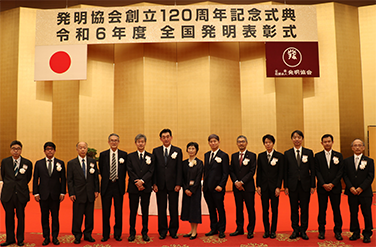
ENEOS, along with Yokohama National University and De Nora Permelec Ltd., received the Future Creation Invention Encouragement Award and the Future Creation Invention Contribution Award1 at the Reiwa 6 (2024) National Commendation for Invention2. The invention for which these three parties were awarded is an “invention of highly durable apparatus and method for producing organic hydride as hydrogen carrier” (Patent No. 6758628).
Direct MCH® is a technology for producing an organic hydride methylcyclohexane (MCH) directly from toluene by the electrochemical reaction using electricity derived from renewable energy. MCH is a hydrogen carrier with potential uses as a renewable energy storage and transport media. The technology reduces costs compared to conventional methods and is expected to contribute to the realization of a carbon-neutral society. The award-winning invention, which significantly reduces the decline in production efficiency of electrolyzers over time, contributed to the success of the green hydrogen supply chain demonstration between Japan and Australia3 in 2023.
- 1The Future Creation Invention Encouragement Award is given for inventions judged to be particularly outstanding from among those that have demonstrated effects or are expected to have significant effects in the future. The Future Creation Invention Contribution Award is given when the invention is made by a corporation.
- 2The National Commendation for Invention is administered by the Japan Institute of Invention and Innovation. The award, which is the most prestigious award related to intellectual property in Japan, was created to contribute to the enhancement of science and technology and the development of industry in Japan.
- 3This demonstration was conducted as part of Green Innovation Fund Projects of Direct MCH electrosynthesis technology development commissioned by the New Energy and Industrial Technology Development Organization (NEDO).